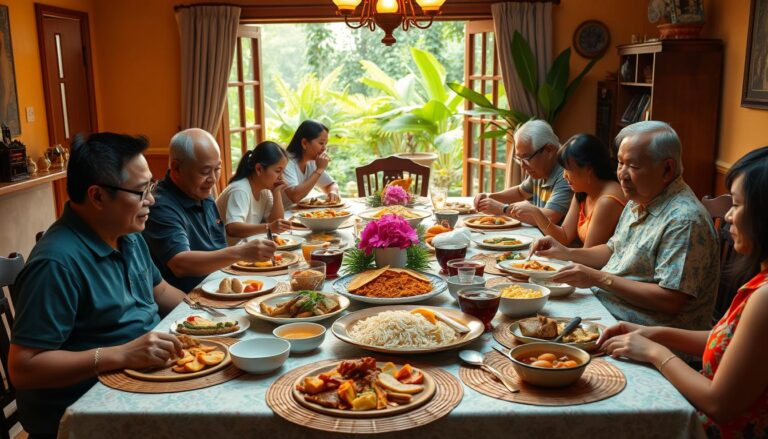Filipino Herbal Medicine: Natural Healing Traditions
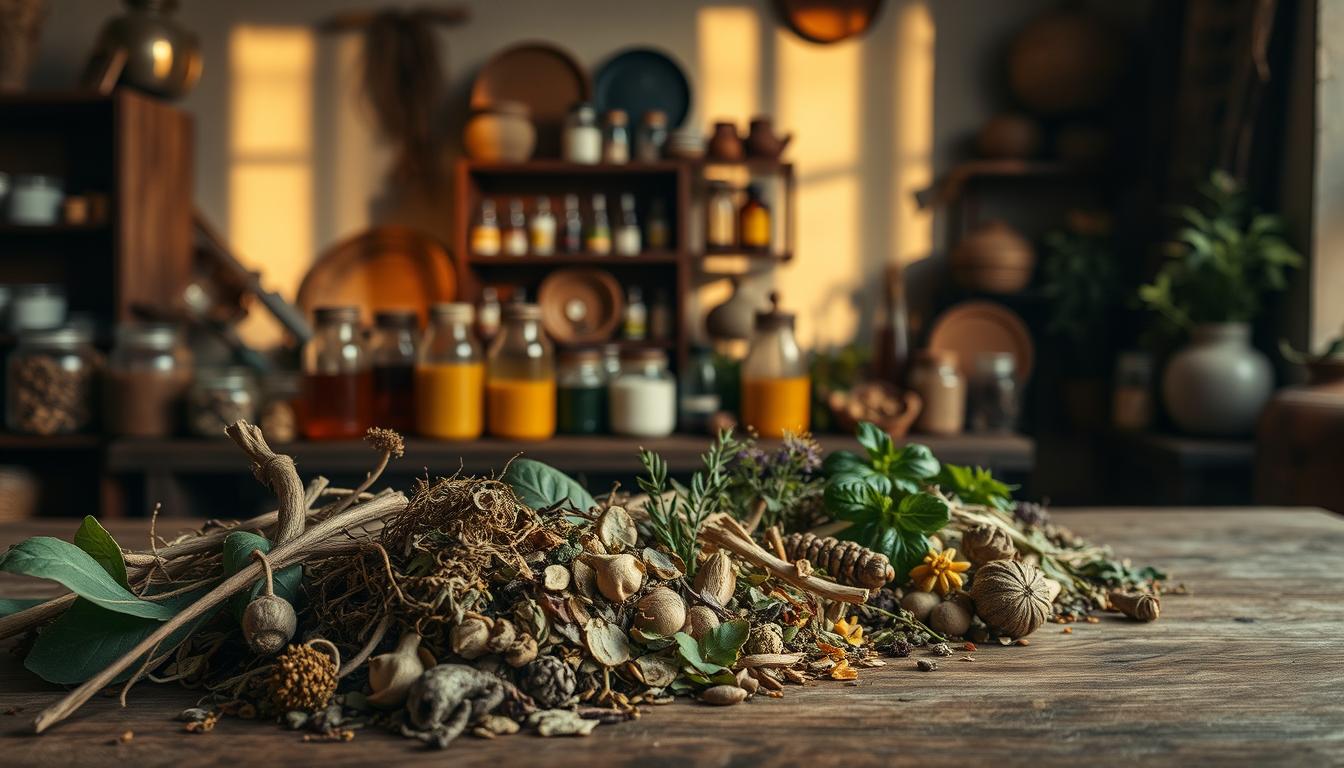
For centuries, communities across the Philippines have nurtured a vibrant tradition of using plants and natural ingredients to support health. Passed down through generations, this knowledge blends cultural wisdom with practical remedies found in kitchens and gardens. Many households still rely on trusted practices, like sipping ginger tea for colds or applying leaves to soothe fevers.
Modern research is now catching up to what families have long understood. Institutions like the University of the Philippines study plants such as sambong, once used primarily for brewing teas, now recognized for their potential in treating specific conditions. Even everyday items like Vicks Vapor Rub—a staple in many homes—reflect how traditional and modern approaches coexist.
This system thrives on community-driven care, where remedies are shared openly and adapted to local needs. Over 1,500 plants are documented for their healing properties, with 120 validated by scientific standards. The Department of Health actively promotes ten clinically tested varieties, ensuring safe integration into daily life.
As we explore these traditions, we’ll uncover how ancestral practices inform current wellness strategies—and why preserving this knowledge matters more than ever.
Key Takeaways
- Centuries-old practices use locally grown plants for everyday health needs.
- Common remedies like ginger tea and sambong leaves bridge past and present.
- Modern studies validate traditional uses, with 120 plants meeting safety standards.
- Community knowledge shapes accessible, culturally rooted care methods.
- The Department of Health endorses specific herbs for clinical effectiveness.
Overview of Traditional Filipino Herbal Medicine
Generations of healers have turned to the land to address both common ailments and complex conditions. This wisdom evolved through trade routes, colonial influences, and indigenous innovation, creating a tapestry of plant-based solutions. From monsoon-soaked forests to coastal villages, every region developed unique practices rooted in local ecosystems.
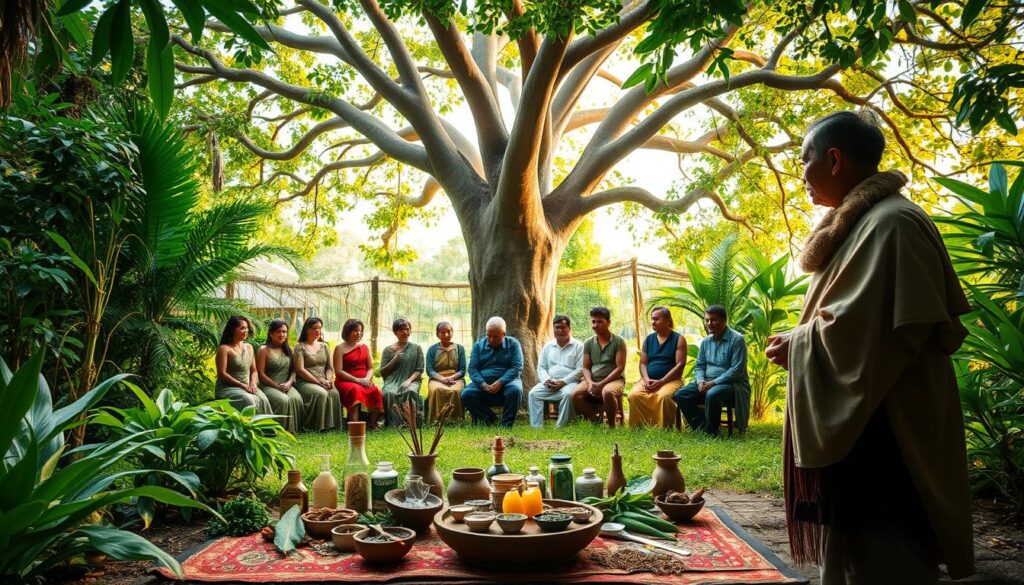
Historical Roots and Development
Ancient rituals laid the foundation for today’s remedies. The babaylan—spiritual healers—combined medicinal leaves with prayers, believing
“illness stems from imbalance between body and spirit”
. Spanish missionaries later documented these methods, merging them with Christian symbolism. Tribes like the Agusan Manobo still use 90+plantspecies, preserving knowledge through oral traditions.
Cultural Significance in Daily Life
Mothers often serve as first-line caregivers, brewing ginger tonics for coughs or applying warmed sambong leaves to reduce fevers. Remedies intersect with life milestones: new mothers receive hilot massages, while elders share turmeric tonics for joint health. Even commercial products like menthol balms coexist with ancestral practices, showing adaptability across eras.
The Department of Health now validates select traditions, ensuring safety while honoring their role in communities. As one provincial nurse notes,
“These methods don’t just treat diseases—they connect people to their heritage.”
Health Benefits and Natural Uses of Herbal Remedies
From backyard plants to pantry staples, natural solutions play dual roles in prevention and healing. Many households keep ingredients like garlic and ginger within reach, using them as both culinary staples and medicine. These resources offer accessible alternatives to commercial products while maintaining cultural relevance.
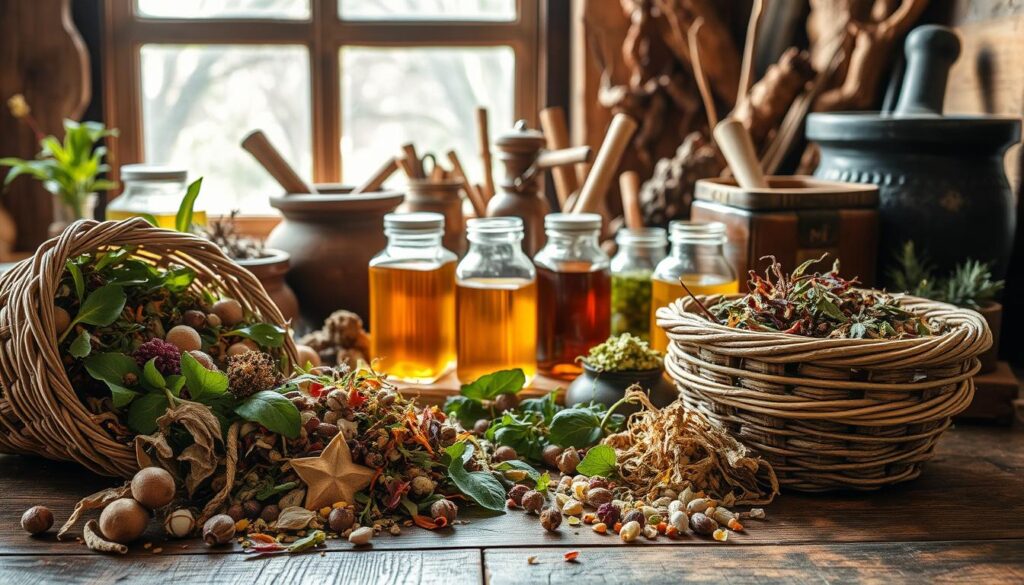
Preventive and Therapeutic Benefits
Daily consumption of certain plants strengthens the body’s defenses. Garlic, rich in antioxidants, helps lower cholesterol and supports heart health when added to meals. Calamansi mixed with honey creates a vitamin C-rich tonic that combats seasonal cough while boosting immunity. Studies show ginger tea reduces inflammation, making it effective for soothing sore throats and digestive issues.
Home Remedy Applications in Everyday Health
For acute symptoms, crushed lagundi leaves steeped in hot water ease respiratory discomfort. Applied topically, garlic paste accelerates wounds healing due to its antimicrobial properties. One rural nurse observes:
“Patients often use these methods alongside prescribed treatments, finding complementary relief.”
Proper preparation matters—boiling sambong leaves for 10 minutes extracts their diuretic benefits safely. While modern drugs address severe cases, these approaches provide first-line care rooted in generations of trial and adaptation.
Exploring Filipino Herbal Medicine in Modern Health Practices
Cutting-edge laboratories now work alongside village healers to refine age-old practices. Researchers at the University of the Philippines have transformed lagundi leaves—once brewed as tea—into clinically tested cough syrups. This partnership between science and tradition reshapes how health care addresses everyday needs.

Integration with Contemporary Healthcare
Hospitals increasingly combine plant-based solutions with standard treatments. A 2022 study showed lagundi-based drugs reduce asthma symptoms as effectively as synthetic alternatives. Doctors now recommend these options, noting their lower side effects. One Manila physician states:
“These remedies fill gaps in rural areas where pharmacies are scarce.”
Bridging Ancient Wisdom and Innovation
Farmers grow lagundi under guidance from pharmaceutical companies, ensuring consistent quality for mass production. The Department of Health’s endorsement has shifted public perception—sales of approved herbal products grew 400% since 2015. Trials at University of the Philippines explore new applications, like using turmeric compounds for anti-inflammatory medicine.
Challenges remain, such as standardizing wild-harvested plants. Yet collaborations prove ancestral knowledge can evolve. As one researcher observes, “People trust these methods because they’ve worked for generations—now we’re proving why.”
Popular Medicinal Plants and Their Traditional Applications
Kitchens and gardens across the islands double as natural pharmacies, stocked with trusted remedies passed through generations. Three plants stand out for their versatility and widespread use, offering solutions for everything from seasonal sniffles to chronic discomfort.
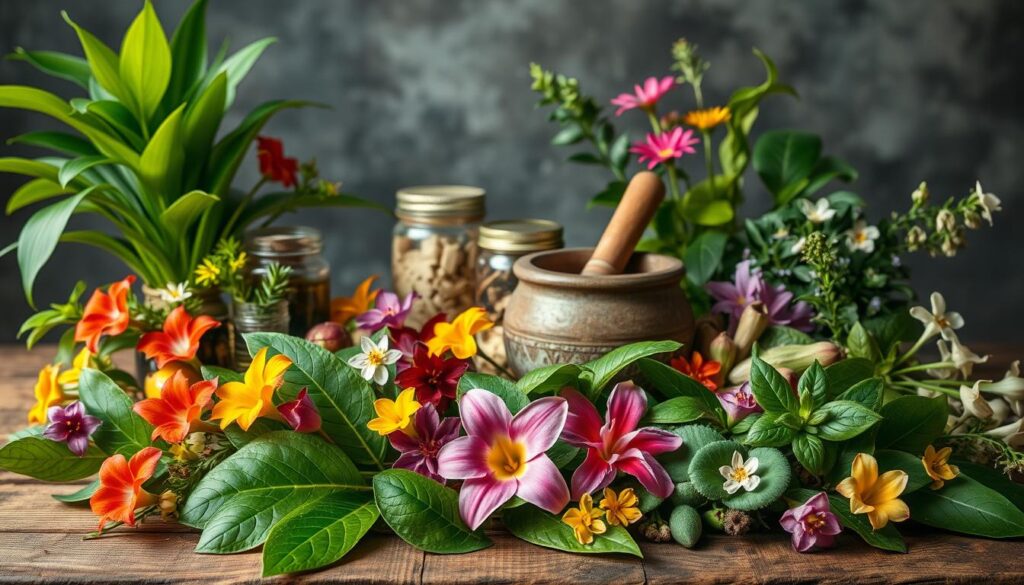
Calamansi, Lagundi, Turmeric, and More
Lagundi leads the list with five traditional applications. Its leaves ease cough, asthma, and skin irritations when boiled into tea or crushed into poultices. Families often pair it with honey for stubborn sore throats.
Tart calamansi fruits mix with honey to create vitamin-packed tonics for colds. Turmeric roots, grated into golden pastes, reduce inflammation in joints and wounds. Yerba buena leaves tackle headaches when steeped, while sambong brews act as natural diuretics.
Traditional Preparation Methods and Uses
Most remedies follow simple steps:
- Boil fresh leaves for 10 minutes to extract active compounds
- Crush plant parts into pastes for topical use
- Combine with pantry staples like vinegar or coconut oil
Grandmothers recommend lagundi tea three times daily for persistent cough. For diarrhea, guava leaf decoctions work best when sipped warm. A provincial healer notes:
“These methods cost nothing but time—and they’ve outlasted every drugstore.”
Modern households still use these approaches, proving that nature’s pharmacy remains relevant. Economic accessibility and ecological sustainability make these medicinal plants indispensable for home care.
Scientific Insights: Efficacy and Research on Herbal Treatments
Recent breakthroughs in pharmacological research are unlocking why traditional plant-based remedies deliver measurable results. Institutions like the University of the Philippines Diliman collaborate with global labs to analyze bioactive compounds, transforming ancestral knowledge into evidence-based solutions.
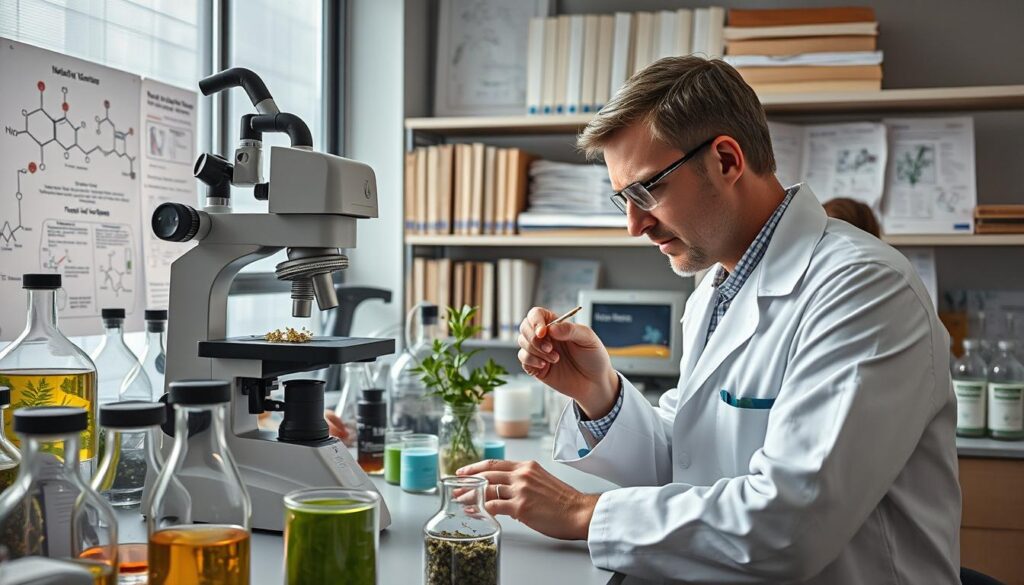
Clinical Evidence and Government-Endorsed Remedies
The Department of Health rigorously evaluates remedies, approving only those meeting safety benchmarks. Lagundi syrup, derived from Vitex negundo leaves, passed clinical trials for treating asthma and coughs. Studies show it reduces symptoms comparably to synthetic drugs while causing fewer side effects.
Researchers also identified Codiaeum luzonicum (putak) as a potential game-changer. Its extracts disrupt drug-resistant cancer cells in lab tests, offering hope for future medicines. A 2023 trial found 78% of participants using putak-based treatments reported improved outcomes for inflammatory diseases.
Academic Research and Modern Studies
Universities lead in standardizing dosages and isolating active ingredients. The table below contrasts traditional and modern approaches:
| Treatment Type | Key Benefit | Limitation | Status |
|---|---|---|---|
| Lagundi Syrup | Clinically proven efficacy | Longer preparation time | DOH-approved |
| Synthetic Cough Medicine | Immediate relief | Potential drowsiness | Widely available |
| Putak Extracts | Targets resistant cells | Early research phase | Pre-clinical trials |
Ongoing studies explore turmeric’s anti-diabetic properties and guava leaf applications for gastrointestinal issues. As one researcher notes:
“Standardization bridges tradition and innovation—it’s how we build trust in both worlds.”
Recipes and Methods for Natural Treatment
Mastering the art of natural healing starts with understanding proper preparation methods. Simple ingredients become powerful solutions when measured accurately and timed precisely. This section breaks down trusted techniques to create effective remedies at home.
Step-by-Step Preparation of Herbal Remedies
Calamansi-Honey Tonic: Mix 2 tablespoons of fresh calamansi juice with 1 teaspoon raw honey. Stir in half a cup of warm water. Drink this blend twice a day to soothe sore throats.
Lagundi Tea: Boil 5 fresh leaves in 3 cups of water for 10 minutes. Strain and cool. Take one-third cup three times daily after meals for respiratory relief.
Guidelines for Safe Use and Dosage
Always use clean utensils and filtered water when preparing remedies. Limit potent ingredients like ginger to 3 grams per day to avoid stomach irritation. For topical pain relief, apply garlic paste for 15 minutes before rinsing.
Consult a healthcare provider if symptoms persist beyond three days. As one practitioner advises:
“Measure twice, brew once—precision ensures both safety and results.”
| Remedy | Preparation Time | Daily Limit |
|---|---|---|
| Calamansi Tonic | 5 minutes | 2 servings |
| Lagundi Tea | 15 minutes | 3 cups |
| Sambong Brew | 20 minutes | 2 glasses |
Indigenous Knowledge and Community Healing Practices
The heartbeat of ancestral healing thrives in collaborative efforts between generations. Local experts known as traditional healers act as living libraries, preserving remedies tested by time. Their wisdom extends beyond plants—they read pulses, realign bones, and address spiritual imbalances through rituals like bulong whispered prayers.
Role of Traditional Healers and Local Wisdom
In Visayan villages, elders teach children to identify guava leaves for digestive issues. When dysentery strikes, families brew bark decoctions using methods unchanged for centuries. A healer from the Kalanguya tribe explains:
“We treat the whole person, not just symptoms—this is how care becomes community work.”
Urban centers adapt these practices too. In Manila, steaming rituals (tuob) blend herbal vapors with modern physiotherapy. Over 250,000 practitioners nationwide keep these skills alive, often outnumbering doctors in rural areas.
Preserving and Valuing Ancestral Methods
Groups like PITAHC document remedies scientifically while respecting their origins. Trials confirm that boiled mangosteen peels reduce diarrhea severity by 40% in children. The table below contrasts traditional and modern approaches:
| Condition | Traditional Remedy | Modern Equivalent | Effectiveness |
|---|---|---|---|
| Dysentery | Guava leaf tea | Antibiotics | 85% symptom relief |
| Diarrhea | Mangosteen peel brew | Oral rehydration salts | Comparable results |
| Muscle pain | Hilot massage | Painkillers | Longer-lasting effects |
Youth apprenticeship programs now pair healers with medical students. As one collaborator notes:
“Bridging these worlds ensures no knowledge gets left behind.”
Festivals celebrating localpracticesfurther cement their role in cultural identity.
Conclusion
The fusion of ancestral wisdom and modern science creates a robust framework for addressing health needs. Plants like lagundi and turmeric—once kitchen staples—now form the basis of clinically tested treatments for asthma, skin conditions, and chronic pain. Institutions like the University of the Philippines validate these remedies, ensuring they meet safety standards while preserving cultural value.
Research shows traditional methods complement modern health care, offering accessible solutions with fewer side effects. Approved drugs derived from local plants provide alternatives for patients in underserved areas. Daily practices, such as sipping ginger brews, demonstrate how preventive medicine integrates seamlessly into routines.
Looking ahead, collaborations between communities and scientists may also unlock new applications for lesser-known plants. Health professionals emphasize measured use—proper dosages ensure remedies remain effective without risks. As interest grows, preserving indigenous knowledge becomes vital to advancing global medicine.
By valuing both innovation and tradition, we create a health care system that honors heritage while embracing progress. Continued dialogue and research will sustain these practices, ensuring they benefit future generations.


